Learn more about Urbanism Next:
[embeddoc url=”https://urbanismnext.uoregon.edu/files/2017/06/Urbanism-Next-Framework_080618-t65jcs.pdf” download=”all” viewer=”google” ]
While the Urbanism Next blog presents a compilation of research and articles from a variety of sources, we are also conducting our own research. This page includes a series of papers on issues related to Urbanism Next. The intention is to introduce you to some key topics that will be affecting how cities develop as they face ongoing and transformative changes in technology.
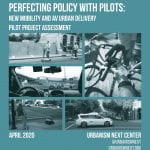 Perfecting Policy with Pilots: New Mobility and AV Delivery Pilot Project Assessment is an assessment of 220 pilot projects from around the country.
Perfecting Policy with Pilots: New Mobility and AV Delivery Pilot Project Assessment is an assessment of 220 pilot projects from around the country.
Urbanism Next Framework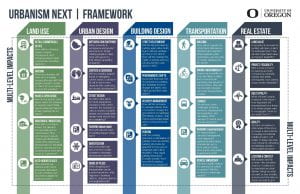 (Urbanism Next) One of the key challenges cities face is understanding the range of areas that are being affected or will be affected by emerging technologies, and how these areas are related. The Urbanism Next Framework organizes impacts based on five key areas— land use, urban design, building design, transportation, and real estate—and relates those to the implications they have on equity, health and safety, the environment, and the economy. It then considers what we should do to ensure that emerging technologies help communities achieve their goals.
(Urbanism Next) One of the key challenges cities face is understanding the range of areas that are being affected or will be affected by emerging technologies, and how these areas are related. The Urbanism Next Framework organizes impacts based on five key areas— land use, urban design, building design, transportation, and real estate—and relates those to the implications they have on equity, health and safety, the environment, and the economy. It then considers what we should do to ensure that emerging technologies help communities achieve their goals.
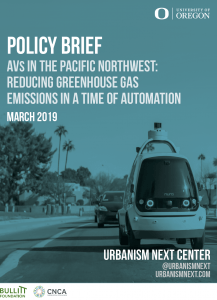 Policy Brief: AVs in the Pacific Northwest: Reducing Greenhouse Gas Emissions in a Time of Automation (Howell, Larco, Lewis, and Steckler) summarizes the key takeaways from New Mobility in the Right-of-Way and AVs in the Pacific Northwest. (Both reports are included below.) This policy brief outlines our main findings and includes a series of process/procedural and policy recommendations for cities to consider as they adopt new mobility plans and enable automated vehicles.
Policy Brief: AVs in the Pacific Northwest: Reducing Greenhouse Gas Emissions in a Time of Automation (Howell, Larco, Lewis, and Steckler) summarizes the key takeaways from New Mobility in the Right-of-Way and AVs in the Pacific Northwest. (Both reports are included below.) This policy brief outlines our main findings and includes a series of process/procedural and policy recommendations for cities to consider as they adopt new mobility plans and enable automated vehicles.
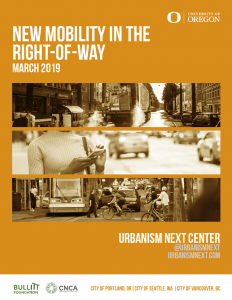 New Mobility in the Right-of-Way (Howell, Larco, Lewis, and Steckler) explores the ways in which demand for the right-of-way, broadly, but the curb, more specifically, is changing. The curb has long been in high demand with multiple users vying for limited space, especially for the purposes of parking personal vehicles. However, TNCs and other services have helped to usher in a new age that involves an increased demand for short-term loading and micromobility device parking. AVs will likely exacerbate existing issues with the right-of-way and the curb, which is why it is important that cities tackle curb management in new ways. This report categorizes and summarizes efforts that are already underway in cities across the world to rethink curb management and identifies major research gaps. New Mobility in the Right-of-Way summarizes the second phase of research from a project involving the Carbon Neutral Cities Alliance at the Urban Sustainability Directors Network (CNCA/USDN) and the cities of Portland, OR; Seattle, WA; and Vancouver, BC, and was generously supported by the Bullitt Foundation.
New Mobility in the Right-of-Way (Howell, Larco, Lewis, and Steckler) explores the ways in which demand for the right-of-way, broadly, but the curb, more specifically, is changing. The curb has long been in high demand with multiple users vying for limited space, especially for the purposes of parking personal vehicles. However, TNCs and other services have helped to usher in a new age that involves an increased demand for short-term loading and micromobility device parking. AVs will likely exacerbate existing issues with the right-of-way and the curb, which is why it is important that cities tackle curb management in new ways. This report categorizes and summarizes efforts that are already underway in cities across the world to rethink curb management and identifies major research gaps. New Mobility in the Right-of-Way summarizes the second phase of research from a project involving the Carbon Neutral Cities Alliance at the Urban Sustainability Directors Network (CNCA/USDN) and the cities of Portland, OR; Seattle, WA; and Vancouver, BC, and was generously supported by the Bullitt Foundation.
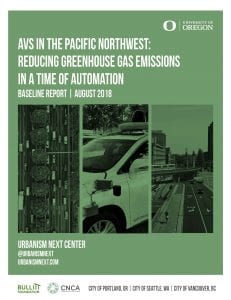 AVs in the Pacific Northwest: Reducing Greenhouse Gas Emissions in a Time of Automation (Larco, Howell, Lewis, and Steckler). The policy decisions made over the next 10 years that shape the deployment of autonomous vehicles (AVs) will have significant repercussions for our communities as well as environmental repercussions related to greenhouse gas emissions and adaptation to climate change. In recognition of that, Urbanism Next worked with the cities of Portland, Seattle, and Vancouver, BC to better understand how new mobility technologies such as AVs could affect greenhouse gas emissions thereby impacting their ability to achieve the goals in their respective climate action plans. This project grew out of a partnership between the Carbon Neutral Cities Alliance at the Urban Sustainability Directors Network (CNCA/USDN) and the Cities of Portland, Seattle, and Vancouver and was generously supported by the Bullitt Foundation.
AVs in the Pacific Northwest: Reducing Greenhouse Gas Emissions in a Time of Automation (Larco, Howell, Lewis, and Steckler). The policy decisions made over the next 10 years that shape the deployment of autonomous vehicles (AVs) will have significant repercussions for our communities as well as environmental repercussions related to greenhouse gas emissions and adaptation to climate change. In recognition of that, Urbanism Next worked with the cities of Portland, Seattle, and Vancouver, BC to better understand how new mobility technologies such as AVs could affect greenhouse gas emissions thereby impacting their ability to achieve the goals in their respective climate action plans. This project grew out of a partnership between the Carbon Neutral Cities Alliance at the Urban Sustainability Directors Network (CNCA/USDN) and the Cities of Portland, Seattle, and Vancouver and was generously supported by the Bullitt Foundation.
Rethinking Streets in an Era of Driverless Cars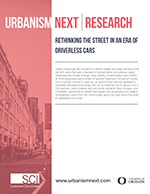 (Schlossberg, Riggs, Millard-Ball and Shay) presents ideas about how city planners, policy makers and community residents can address the introduction of autonomous vehicles. This white paper frames the introduction of AVs as an opportunity to rethink streets with purposeful and creative consideration about how this critical public good may best serve the public for generations to come.
(Schlossberg, Riggs, Millard-Ball and Shay) presents ideas about how city planners, policy makers and community residents can address the introduction of autonomous vehicles. This white paper frames the introduction of AVs as an opportunity to rethink streets with purposeful and creative consideration about how this critical public good may best serve the public for generations to come.
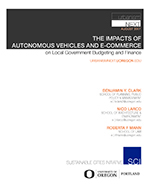 The Impact of AVs and E-Commerce on Local Government Budgeting and Finance (Clark, Larco and Mann) is a new report from us here at Urbanism Next/SCI that takes you through a city’s budget —both revenues and expenditures — and describes the areas that will be affected as AVs become commonplace and e-commerce takes on an even larger role in retail. City leaders have to start planning for this future now if they want to have a voice in what AVs/e-commerce will do to their cities.
The Impact of AVs and E-Commerce on Local Government Budgeting and Finance (Clark, Larco and Mann) is a new report from us here at Urbanism Next/SCI that takes you through a city’s budget —both revenues and expenditures — and describes the areas that will be affected as AVs become commonplace and e-commerce takes on an even larger role in retail. City leaders have to start planning for this future now if they want to have a voice in what AVs/e-commerce will do to their cities.
 Re-Imagining Retail (Carlson and Larco) builds on earlier posts about the challenges retail is currently facing, we look at the transformation retail is currently going through and the shift from brick-and-mortar, to e-commerce, to omnichannel approaches. The paper describes trends and includes data and resources that can help you understand where we are at, where we are heading, and where you can learn more.
Re-Imagining Retail (Carlson and Larco) builds on earlier posts about the challenges retail is currently facing, we look at the transformation retail is currently going through and the shift from brick-and-mortar, to e-commerce, to omnichannel approaches. The paper describes trends and includes data and resources that can help you understand where we are at, where we are heading, and where you can learn more.
 Warehousing (Carlson and Larco) looks at the changing nature of distribution networks with the rise of E-Commerce and the effects this will have on the size, number and distribution of Warehouses in cities.
Warehousing (Carlson and Larco) looks at the changing nature of distribution networks with the rise of E-Commerce and the effects this will have on the size, number and distribution of Warehouses in cities.
Advances in technology such as the advent of autonomous vehicles (AVs), the rise of E-commerce, and the proliferation of the sharing economy are having profound effects not only on how we live, move, and spend our time in cities, but also increasingly on urban form and development itself. The University of Oregon’s Urbanism Next Center focuses on the ramifications of these changes. Researchers are working with leaders from the public, private, and academic sectors across North America and Europe to better understand the secondary impacts of emerging technologies on cities and ensure that governments from the local to federal level have the information they need to make informed decisions that improve equity and health outcomes, as well as help achieve community goals related to the economy and the environment.
Urbanism Next is meant to be a source for those interested in technology and the built environment and is particularly targeted towards urban designers, architects, planners, landscape architects, and developers. The Urbanism Next Blog is part of the Sustainable Cities Initiative’s (SCI) Urbanism Next Research Center at the University of Oregon. Visit the blog for links to relevant articles, commentaries on emerging trends, and critical thinking around the future of our cities.
Learn more about Urbanism Next:
[embeddoc url=”https://urbanismnext.uoregon.edu/files/2017/06/Urbanism-Next-Framework_080618-t65jcs.pdf” download=”all” viewer=”google” ]